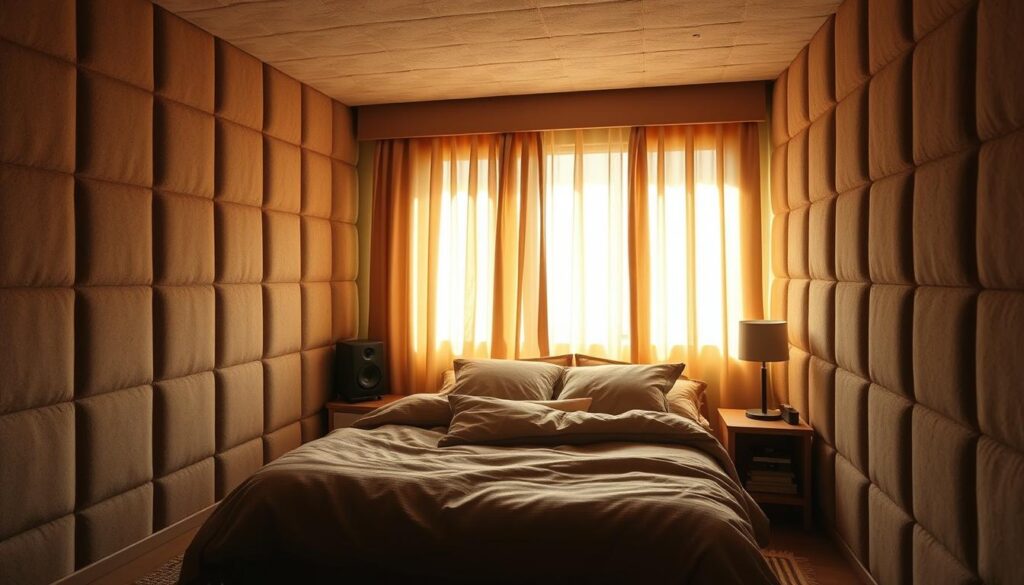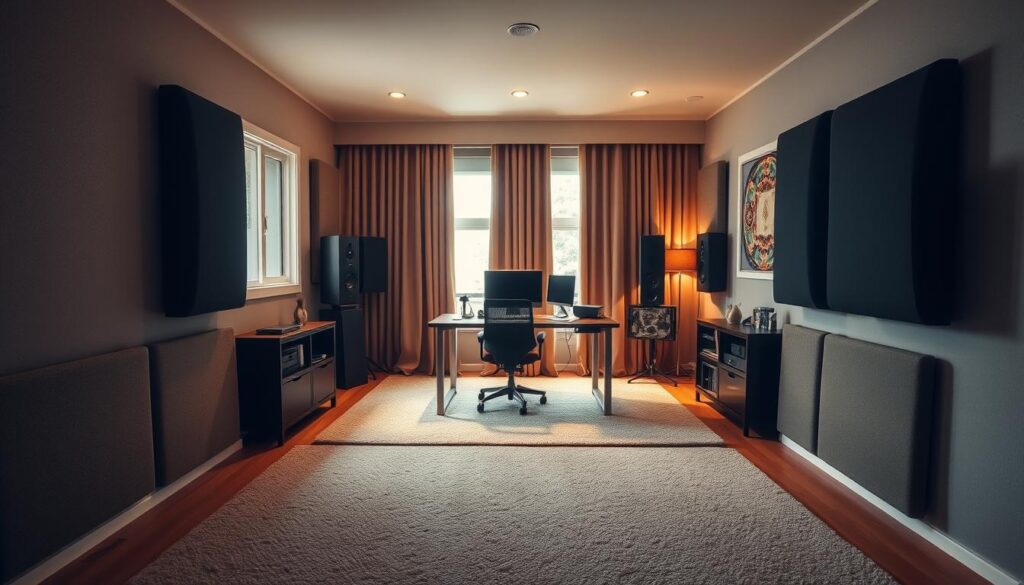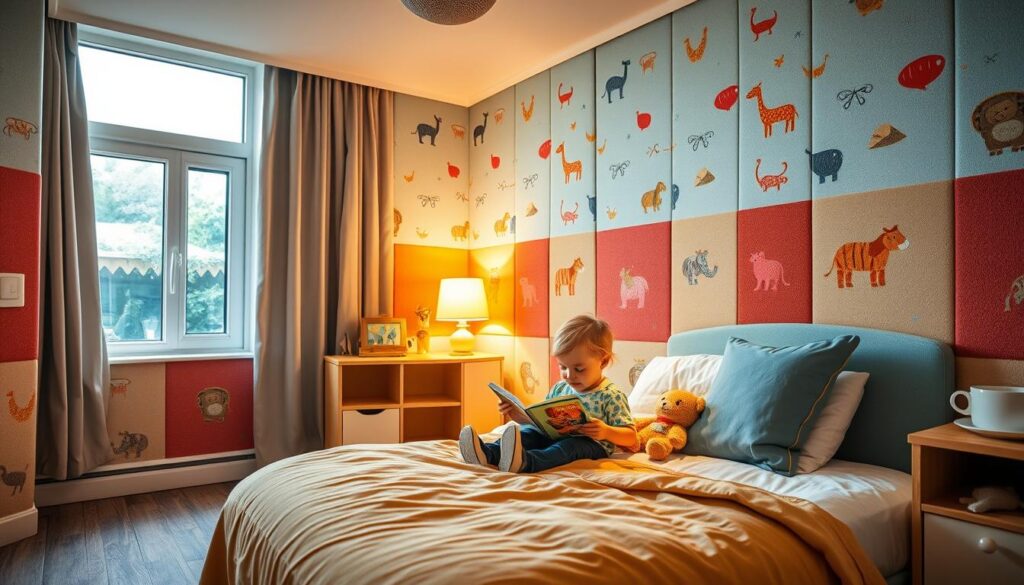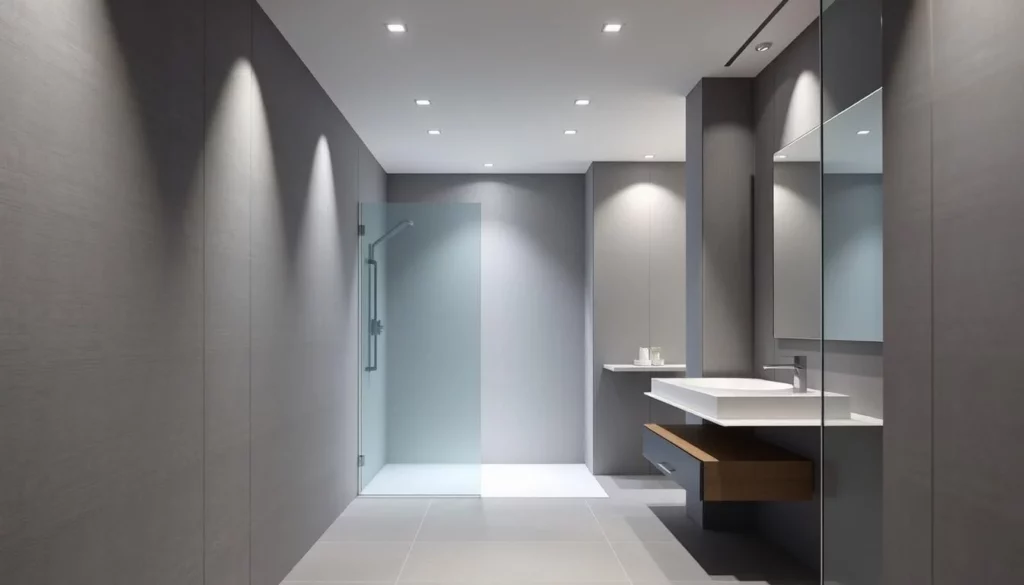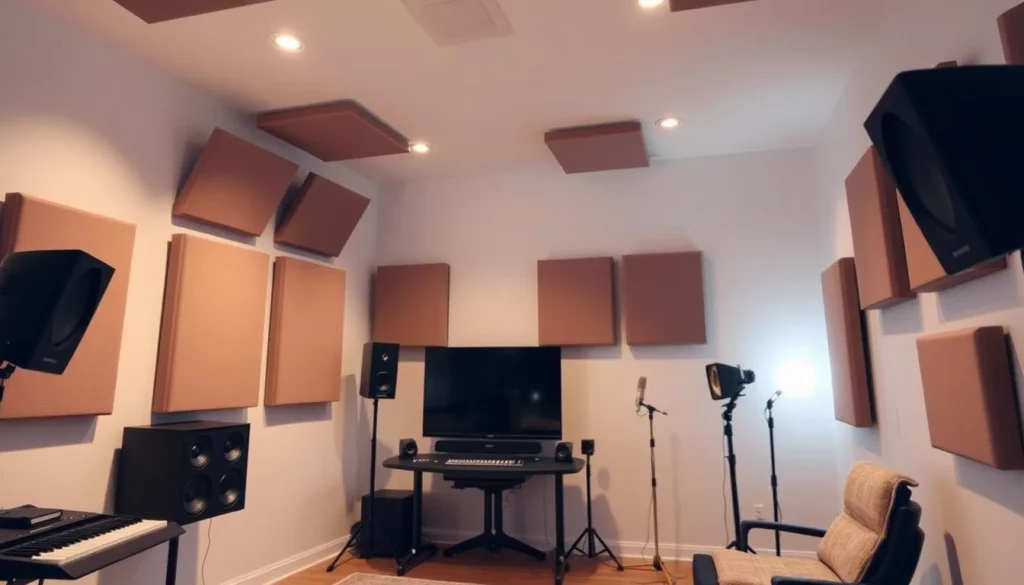Are you tired of outside noise disturbing you or vice versa? Creating a quiet sanctuary in your home is possible with the right soundproofing methods.
Using the right materials and techniques can greatly reduce unwanted noise. Soundproofing your bedroom is more than just blocking out external sounds. It’s about making a peaceful space for better sleep. Simple yet effective strategies can make your bedroom a serene and private retreat.
Effective soundproofing involves sealing gaps and installing acoustic panels. In this article, we’ll dive into these methods. You’ll learn how to make your bedroom quieter and more comfortable.
Understanding Soundproofing Basics
To soundproof your bedroom well, you need to know the basics. Soundproofing isn’t just about stopping noise. It’s about making a space where you can relax or work without interruptions. Knowing the basics helps you choose the right soundproofing solutions for your needs.
What Is Soundproofing?
Soundproofing means making a room quieter by blocking sound from getting in or out. You can use soundproofing materials, seal gaps, and install acoustic panels. The goal is to keep noise levels down, making your room more peaceful.
Good soundproofing can make your bedroom quieter and more relaxing. Knowing what soundproofing is helps you find the best ways to do it for your space.
How Sound Travels
Sound moves through the air, walls, and floors in different ways. Knowing how sound travels helps you pick the best soundproofing methods. Sound can go straight through the air or indirectly through walls and ceilings.
To understand sound travel and how to block it, let’s look at sound paths and materials that help reduce noise.
| Sound Transmission Path | Description | Soundproofing Solution |
|---|---|---|
| Airborne Sound | Sound that travels through the air | Acoustic panels, soundproof curtains |
| Structure-borne Sound | Sound that travels through walls and floors | Mass loaded vinyl, decoupling walls |
| Impact Sound | Sound generated by impact on a surface | Area rugs, underlayment for flooring |
By knowing how sound travels and using the right solutions, you can make your bedroom quieter. This improves your life quality a lot.
Assessing Noise Sources in Your Bedroom
Finding out where the noise in your bedroom comes from is crucial for soundproofing. First, you must know the different kinds of noise you face.
Identifying External Noise
External noises can really disturb your bedroom’s peace. Common noises include:
- Traffic noise from nearby roads
- Noise from neighbors, such as loud conversations or music
- Outdoor activities, like construction or lawn care
To lessen these sounds, think about using soundproofing materials. You can put acoustic panels or mass loaded vinyl on your walls and ceilings.
Recognizing Internal Noise
Internal noises are also a big problem. These can be:
- Snoring or other sounds from family members or roommates
- Loud music or TV sounds
- Noise from household appliances, like air conditioners or refrigerators
To cut down on internal noise, try using soundproofing curtains. Or, install acoustic panels in key spots in your bedroom.
By tackling both external and internal noises, you can greatly enhance your bedroom’s soundproofing. This makes it a much quieter and more peaceful space.
Choosing the Right Materials for Soundproofing
Effective bedroom soundproofing starts with choosing the correct materials. The right materials can significantly reduce noise, creating a more peaceful environment.
Several materials are effective for soundproofing. These include acoustic panels, soundproof curtains, and mass loaded vinyl. Each has its own benefits and uses.
Acoustic Panels
Acoustic panels absorb sound waves, reducing echo and reverberation. They are great for controlling internal noise. Place them on walls or ceilings to minimize sound reflection.
Soundproof Curtains
Soundproof curtains are a simple way to block external noise through windows. They are made of thick, heavy materials that absorb sound. Make sure they are sealed well for best results.
Mass Loaded Vinyl
Mass loaded vinyl is a thin, flexible material that blocks sound well. It can be applied to walls, ceilings, and floors to stop sound transmission. It works best with other soundproofing materials.
To pick the right materials, think about the noise type, room size, and budget. For more guidance, check out our article on soundproofing walls.
| Material | Primary Use | Effectiveness |
|---|---|---|
| Acoustic Panels | Internal Noise Control | High |
| Soundproof Curtains | External Noise Reduction | Medium to High |
| Mass Loaded Vinyl | Sound Blocking | High |
Enhancing Door and Window Seals
Improving door and window seals is key to a soundproof bedroom. Sealed doors and windows block noise, making your room quieter and more relaxing.
To soundproof well, focus on two main steps: adding weatherstripping to doors and upgrading windows. Let’s dive into these steps.
Installing Weatherstripping
Weatherstripping is a simple, affordable way to seal door gaps. It stops air leaks and cuts down noise. Choose the right weatherstripping based on your door type and gap size. Options include foam tape, felt, and vinyl.
- Foam Tape: Easy to put on, good for small gaps.
- Felt: A classic choice, comes in different thicknesses.
- Vinyl: Lasts long, stands up to weather.
Upgrading Window Panes
Switching to double or triple-pane windows boosts soundproofing. These windows have gaps that block noise.
| Window Type | Sound Reduction | Cost |
|---|---|---|
| Single Pane | Low | $ |
| Double Pane | Medium to High | $$ |
| Triple Pane | High | $$$ |
When upgrading windows, think about cost, installation, and sound reduction needs. Acoustic or soundproof windows offer the best insulation.
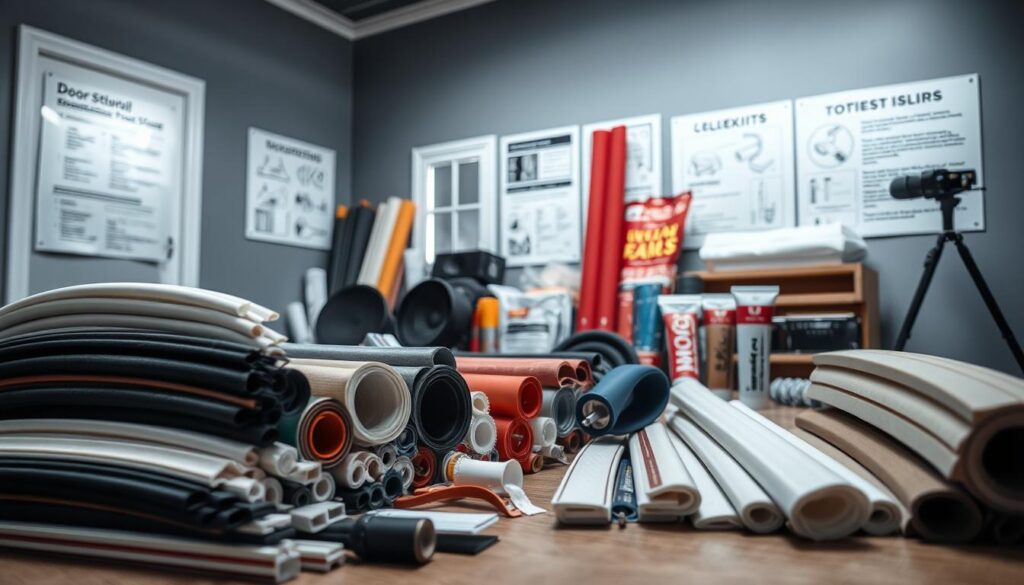
By improving door and window seals, you can make your bedroom quieter. Whether you add weatherstripping or upgrade windows, these steps will help you create a peaceful space.
Utilizing Floor Coverings for Sound Insulation
To make your bedroom quieter, think about the floor covering you choose. It’s not just about looks; it’s key for sound insulation. The right floor covering can boost your bedroom’s soundproofing.
Carpets vs. Hard Flooring
Choosing between carpets and hard flooring is a big decision for sound insulation. Carpets are better at sound insulation because they soak up sound. Hard flooring, with its hard surface, can let more noise through.
- Carpets soak up sound, cutting down on echo and noise.
- Hard flooring can let more noise through but area rugs can help.
Adding Area Rugs
Area rugs are also great for sound insulation in your bedroom. They can cover hard floors, lessening the sound of footsteps and other noises. You can pick from many sizes, materials, and thicknesses to fit your needs.
Here are some perks of using area rugs for sound insulation:
- They can be placed in busy or noisy spots.
- Thicker rugs with dense piles absorb sound better.
- They also add comfort and style to your bedroom.
By picking the right floor coverings like carpets and area rugs, you can greatly improve your bedroom’s sound insulation. This makes your bedroom quieter and more peaceful.
Wall Treatments for Sound Reduction
Treating your bedroom walls is key to reducing noise. Effective treatments can greatly lessen outside noise, making your space quieter.
There are a few ways to soundproof your bedroom walls. Adding drywall and using soundproof paint are two top methods. Let’s dive into these options.
Adding Drywall
Adding extra drywall can soundproof your walls well. It does this by making the wall thicker, which blocks sound waves better. Use high-quality drywall made for soundproofing.
For better results, consider resilient channels. These channels separate the drywall from the studs, cutting down sound vibrations.
Utilizing Soundproof Paint
Soundproof paint is another way to block noise through walls. It absorbs sound energy, reducing echoes and reverberations.
While not as strong as drywall, soundproof paint is still helpful. It’s easy to apply and doesn’t damage walls, making it great for renters or DIY fans.
| Soundproofing Method | Effectiveness | Ease of Installation |
|---|---|---|
| Adding Drywall | High | Moderate |
| Utilizing Soundproof Paint | Moderate | Easy |
Using these wall treatments together can make your bedroom quieter. Whether you add drywall, use soundproof paint, or both, you’re making a big step towards less noise and better living.
Implementing Smart Furniture Arrangements
Smart furniture arrangements can make your bedroom quieter. By placing your furniture wisely, you can block out more noise. This makes your bedroom a more peaceful place.
Positioning Beds and Desks
One easy way to soundproof your bedroom is to move your furniture. Move your bed away from noisy walls, like those near living rooms or kitchens. This cuts down on the noise you hear.
Also, put your desk in a quiet spot. This helps you focus better and reduces distractions.
For example, if your bed is by a noisy hallway, try moving it. Place it against a different wall or in the room’s center. This can block more noise from entering your bedroom.
Using Bookshelves as Sound Barriers
Bookshelves can block noise when placed against noisy walls. Fill them with books and heavy objects to make them better at absorbing sound. This method also makes your room look nicer.
To get the most out of this, make sure your bookshelves are sturdy. Fill them with books and decorations. You can also add acoustic panels to make them even better at blocking sound.
For more tips on soundproofing your bedroom, check out wikiHow’s soundproofing guide. It has lots of helpful advice and techniques.
| Furniture Arrangement | Soundproofing Benefit | Tips for Implementation |
|---|---|---|
| Positioning bed away from noisy walls | Reduces noise transmission | Move bed to a different wall or center of the room |
| Using bookshelves as sound barriers | Absorbs sound, reduces echo | Fill bookshelves with dense objects, place against noisy walls |
| Placing desk in a quiet corner | Reduces distractions, improves focus | Choose a corner away from noisy areas |
Exploring Soundproofing Techniques
Looking into different soundproofing methods can really make your bedroom quieter. It’s key to have a quiet space for peace. There are many ways to make this happen.
Decoupling Walls for Sound Reduction
Decoupling walls is a top soundproofing trick. It makes a gap between the drywall and studs, cutting down on noise. To do this, use resilient channels or soundproofing clips.
These items stop vibrations, so sound can’t pass through walls.
- Resilient channels: These are made to keep drywall from touching studs, which lessens sound.
- Soundproofing clips: These clips hold drywall to walls but block sound.
Adding Soundproofing Foam for Enhanced Noise Reduction
Adding soundproofing foam is another way to cut down on noise. Foam absorbs sound waves, making rooms quieter. When picking foam, think about the noise and room size.
Key considerations include:
- Type of noise: Different foams tackle different sounds.
- Room size: Bigger rooms might need more foam or special placement.
- Budget: Foam prices vary, so pick one that fits your budget.
Using these soundproofing methods can greatly improve your bedroom’s sound quality. This makes your space more peaceful and restful.
Incorporating White Noise Machines
Adding a white noise machine to your bedroom can greatly improve your sleep. These machines help mask background noises. They create a steady sound that blocks out other noises, both inside and outside your room.
Advantages of Using White Noise
White noise machines are great at hiding unwanted sounds, which means better sleep. White noise makes a constant sound that covers up other noises. This is really helpful for people who live in noisy places or who wake up easily.
They also make your room feel more relaxing, which is good for sleep. Plus, they can help you focus when you’re working or studying.
Popular White Noise Machine Models
There are many white noise machines to choose from. Here are some popular ones:
| Model | Features | Price Range |
|---|---|---|
| LectroFan Classic | Offers a variety of fan sounds and ambient noise options | $20-$30 |
| Hatch Rest | Designed for both adults and children, with customizable sound options | $100-$150 |
| DynaTone Sound Machine | Features a wide range of sounds, including nature sounds and white noise | $30-$50 |
When picking a white noise machine, think about the sound it makes, its size, and how much you want to spend. Reading reviews can also help you see how well it works.
In short, using a white noise machine in your bedroom is a smart move. It helps block out noise and makes your sleep environment more consistent. This can really improve how well you sleep.
Maintaining Your Soundproofing Efforts
Soundproofing is not a one-time task. It needs ongoing maintenance to keep your bedroom quiet. Over time, materials can wear out, and seals can lose their effectiveness.
Conducting Regular Inspections
Regular checks are key to keeping your soundproofing up to par. Look at your soundproofing materials like acoustic panels and curtains. Check for any damage that could affect their soundproofing.
Check the seals around doors and windows to make sure they’re tight. Look for gaps or cracks where sound can escape. A candle or incense stick can help find air leaks.
Updating Materials as Needed
It’s important to update your soundproofing materials when needed. If you spot damage, replace or repair the materials. For example, if curtains are torn, you can fix them or get new ones.
Think about getting newer, better soundproofing materials if your current ones aren’t working well. New technologies and materials can offer better soundproofing.
By regularly checking and updating your soundproofing, your bedroom will stay quiet and peaceful. Remember, keeping your soundproofing in good shape is an ongoing task that needs attention.
Professional Soundproofing Services
If you’re having trouble with soundproofing in your bedroom, think about getting help from a pro. They can check out your space and suggest the top ways to block out noise.
Determining the Right Time to Hire a Professional
You might need a pro if outside noise is too loud or if you keep waking up because of noise inside. A professional can find where the noise is coming from and suggest good ways to block it out.
Understanding Costs and Services
The price for professional soundproofing depends on the room size, the noise type, and the materials used. You might spend between $500 to $2,000 for a full soundproofing job. Make sure to look around and compare prices to find the best deal for you.
